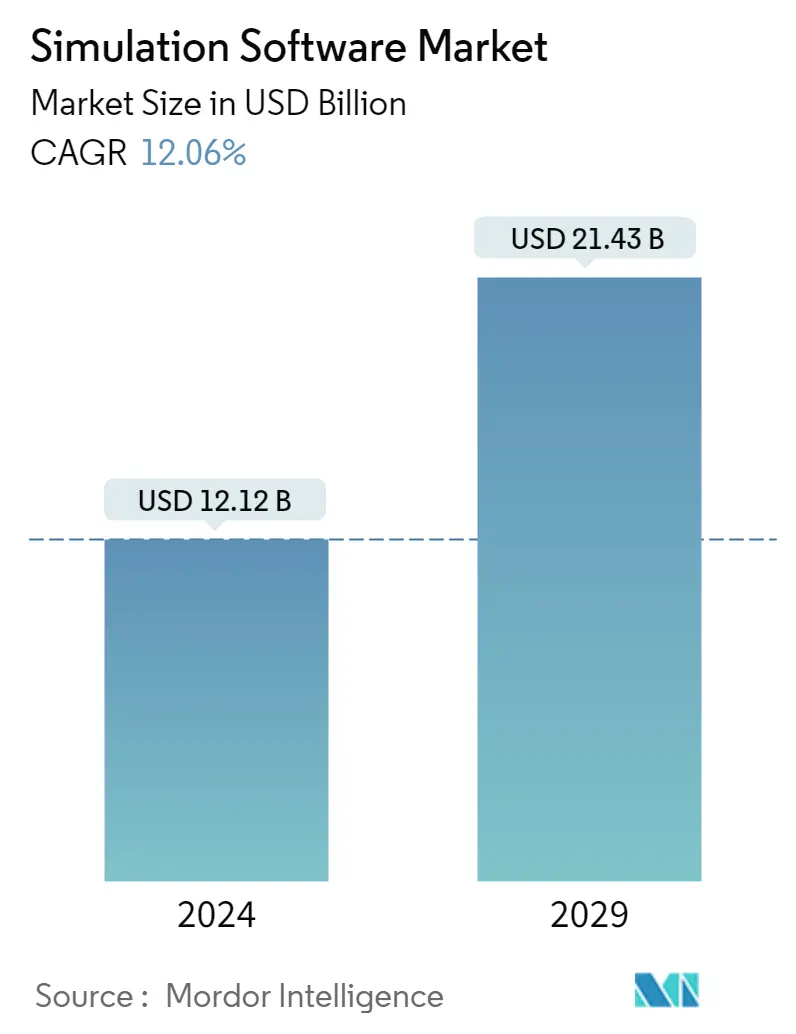Market Size of Simulation Software Industry

| Study Period | 2019 - 2029 |
| Market Size (2024) | USD 12.12 Billion |
| Market Size (2029) | USD 21.43 Billion |
| CAGR (2024 - 2029) | 12.06 % |
| Fastest Growing Market | Asia Pacific |
| Largest Market | North America |
Major Players
*Disclaimer: Major Players sorted in no particular order |
Need a report that reflects how COVID-19 has impacted this market and its growth?
Simulation Software Market Analysis
The Simulation Software Market size is estimated at USD 12.12 billion in 2024, and is expected to reach USD 21.43 billion by 2029, growing at a CAGR of 12.06% during the forecast period (2024-2029).
- Initially, simulation software was only used to tweak production lines. However, in the current market scenario, it is being used to test new concepts, accelerate product developments, and demonstrate regulatory compliance.
- Often, manufacturers invest in simulation software when there is uncertainty about making changes to a production line or when building a new line is too expensive. This is mainly due to the high cost of downtime in terms of operational efficiencies and a manufacturer's reputation on the line if customer orders are delayed. However, new use cases have proven that manufacturers can identify and solve issues in advance by investing in simulation software. Simulation software can also simulate how components work together to create new products and affect process flows to demonstrate compliance.
- A few use cases for simulation software include Siemens modeling Electrolux's factories to identify operational efficiencies and anylogic helping General Dynamic (NASSCO) improve its handling of the thousands of parts flowing through their shipyards. Dassault Systèmes is assisting Global Trailers in fastening the processes for bringing new trailers to the market. Similarly, Fluor, an engineering and construction firm, aspentech, developed a solution to demonstrate that its sulfur tracking technologies help gas plants meet environmental requirements.
- Notably, owing to its superior characteristics, it is widely used in education and the research segment, which may propel the industry growth over the forecast period. Moreover, creating real-time simulation scenarios saves a lot of money and poses less time to execute, which encourages and enhances the core business competencies. Therefore, this is expected to have a positive impact on market growth.
- Furthermore, the upcoming trend of designing toolsets with machine learning capabilities significantly contributes to the market's growth. Also, significant investments were made to empower designers to reduce the number of errors, thereby saving considerable time, which is expected to produce future results.
- Due to the growing demand for advanced manufacturing with intricate designs and the need to reduce the size while improving the performance of automotive compels, automotive manufacturers should increase their R&D investments and adopt simulation software.
- The outbreak of COVID-19 pushed organizations to act quickly to protect employees, address critical challenges, and help fight to minimize losses. Simulation modeling can help organizations to develop strategies to respond quickly, safely, and effectively. For instance, according to Ansys Inc., simulation can be used to design UV light treatment systems for various environments and ensure that sufficient doses of UV light are delivered to deactivate viruses, triggering market growth.
